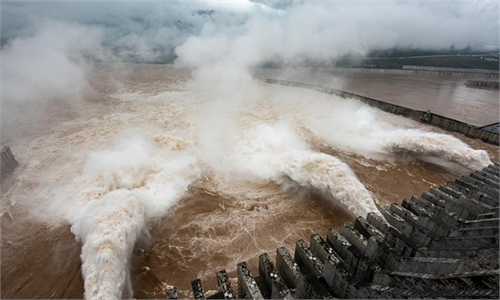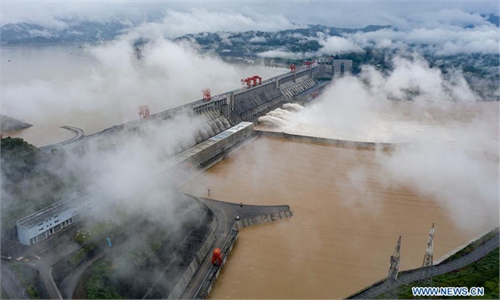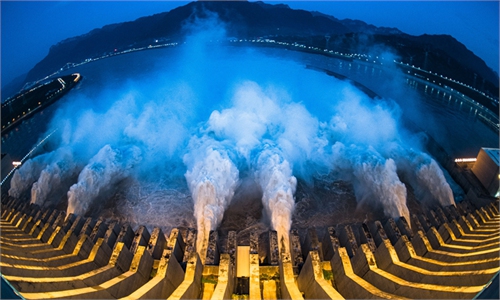Authorities answer to refute misunderstandings, rumors on Three Gorges Dam
Built to last
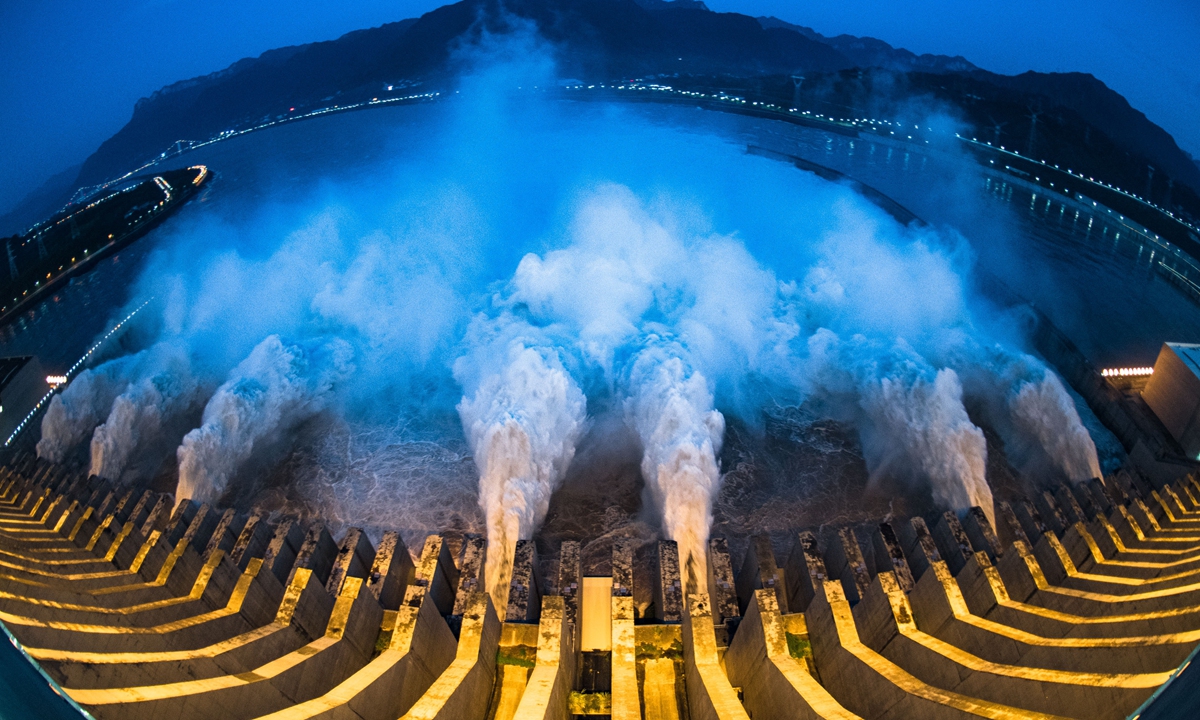
Flood water passes the Three Gorges Dam on Sunday night Photo: Xinhua
Editor's Note:
The Three Gorges Dam, which is China's largest water project, has played a key role in water adjustment and energy generation on the Yangtze River. But even since before it was built in 1994, the project has always been under suspicion and criticism from overseas with some even using it as "evidence" to smear China.
China is fighting a severe flood disaster that has hit more than 20 million people in southern China. The Three Gorges Dam has contributed to mitigating the flood. At 8:00 pm on Sunday, the Yangtze River's second flood of this year steadily passed the Three Gorges Dam.
How has the Three Gorges project functioned during this year's flood? Does it worsen the water disaster in middle and lower reaches of the river? Has it "distorted," or even faced the risk of "collapse," as some media frequently accuse?
The Global Times reporters Shan Jie and Zhao Juecheng interviewed the state-owned Three Gorges Corp, which runs the dam, to gain authoritative answers to these frequent questions and accusations.
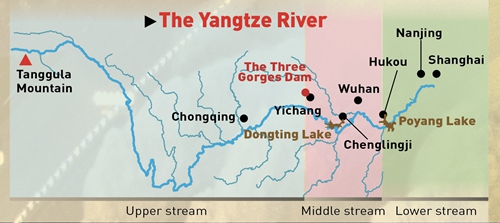
Graphic: GT
Q: This year's flood reminds many people of the one in 1998. If the Three Gorges project was not built, what kind of damage would the flood have brought?
A: In the huge flood in 1998 along the whole Yangtze River basin, the water level at the Shashi hydrologic station in Jingjiang section, which is the most risky part of the river, reached 45.22 meters, 0.22 meters higher than the safety guarantee. The Jingjiang section was facing the choice of flood diversion and was under an intensive situation. More than 1 million of PLA soldiers and local residents were defending against the flood at that time.
According to simulation and calculation, if the Three Gorges Dam had been built in 1998, the water level of Shashi would not have surpassed 44.5 meters, and the flood division amount at Chenglingji region, the exit of Dongting Lake, would have dropped from 10.8 billion cubic meters to 3.5 billion cubic meters, largely releasing the flood defense pressure at the mid- and lower-stream of the Yangtze River.
In terms of this year, if there was no Three Gorges project, water level in Chenglingji region and Hukou, the exit of Poyang Lake, would surpass the safety guarantee level. The Hankou hydrologic station at Wuhan would face a higher water level. In this case, the mid- and lower-stream of the Yangtze River will face a much more intensive situation on flood defense.
Q: Some people say the consistent floodwater discharge of the Three Gorges Dam has aggravated the flood in the middle and lower stream of Yangtze River. Is that true?
A: Discharging floodwater is a way that a reservoir controls outflow water through flood discharge facilities. Usually, the reservoir will let the water flow through generating units. Only when the outflow volume surpasses the capability of the units, would the reservoir apply floodwater discharge channels.
However, discharging floodwater does not mean the reservoir does not apply its flood defense function.
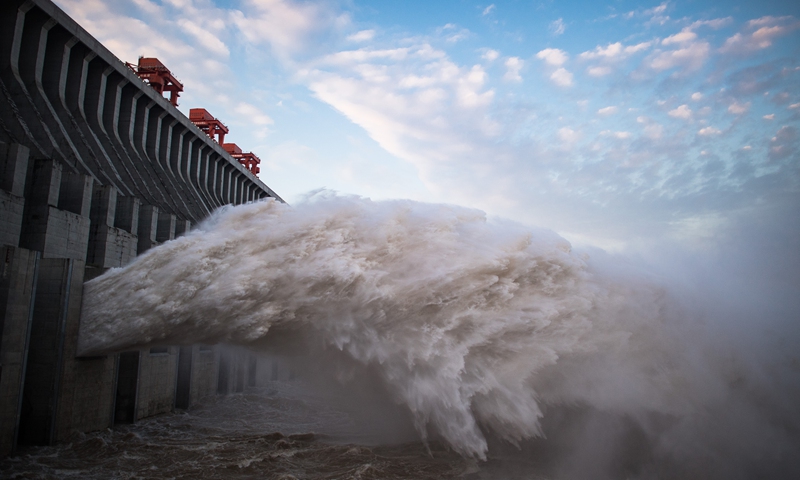
Photo taken on July 19, 2020 shows floodwater being discharged from the Three Gorges Dam in central China's Hubei Province. (Xinhua/Xiao Yijiu)
For instance, on July 2, the Three Gorges reservoir saw an inflow of 53,000 cubic meters per second and an outflow 35,000 cubic meters per second.
The Three Gorges Dam helps ease the pressure of the middle and lower stream region on flood defense, such as the Poyang Lake.
Q: If the flood continues, will the Three Gorges Dam be capable of adjusting the water?
A: The Three Gorges project's duty of flood prevention is mostly based in the Jingjiang section and the Chenglingji region and the exit of Dongting Lake. With a reservoir capacity for floodwater at 22 billion cubic meters, it is designed to prevent huge floods in the upper stream of the Yangtze River with the Three Gorges Dam working significantly to prevent such a situation spiraling out of control.
If flooding occurred via heavy rainfall in the middle and lower reaches of the Yangtze River, the cities surrounding these reaches would have to mainly rely on their own flood drainage facilities. Under such circumstances, the Three Gorges Dam can still make a contribution by retaining and impounding water to ease the pressure on those cities.
Q: Some overseas media hype the "distortion" of the Three Gorges Dam, saying it bears the risk of "collapsing." Is the dam in safe condition?
A: The Three Gorges Dam is running safely in a good condition. During the past few years, there has been no so-called distortion occurring, or any other noteworthy risks.
From 1994 to June of the year, the safety monitoring project has installed 12,000 devices in and around the dam. The monitoring covers distortion, seepage flow and seepage force, stress-strain, powerful earthquakes, hydraulics and dynamics. On top of the advanced monitoring technologies and devices, there are also human inspections to check the condition of the dam.
The working behavior of the buildings and foundation of the Three Gorges Dam are all normal, safe and reliable.
Q: Some say the Three Gorges project affects the ecologic environment along the Yangtze River. What efforts have the corporation and government departments made to protect the environment around the dam and along the river?
A: Apart from flood control, electricity generation and water navigation, a most important task for the Three Gorges Reservoir is to serve as the strategic storage for fresh water resources. With its powerful adjustment capability, the project has played a key role in conservation and repair of ecology and environment along the Yangtze River.
To be specific, the project can replenish water in the lower stream. Since 2003, the reservoir has replenished about 29 billion cubic meters of water to the lower stream.

The Chinese sturgeon released by the Chinese Sturgeon Research Institute of China Three Gorges Corp on April 22 Photo: IC
The project also provides the best conditions for life and reproduction for the wildlife and domestic fish in the Mother River by adjusting and controlling the discharge volume in May and June.
Moreover, it can conduct emergency control. When incidents affecting water quality and safety or maritime crises happen, the project could adjust and control the discharge volume. For instance, in February 2014, the Three Gorges Reservoir enlarged the discharge to the lower stream and effectively restrained the salt tide invasion at the Yangtze River estuary in Shanghai.
Global Times
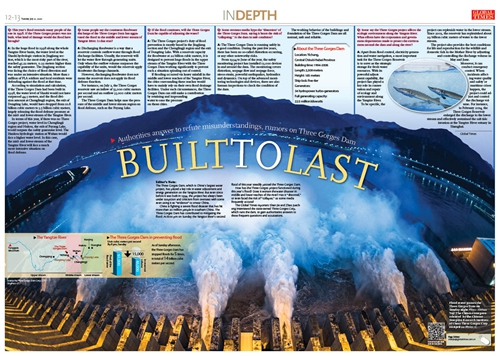
GT

